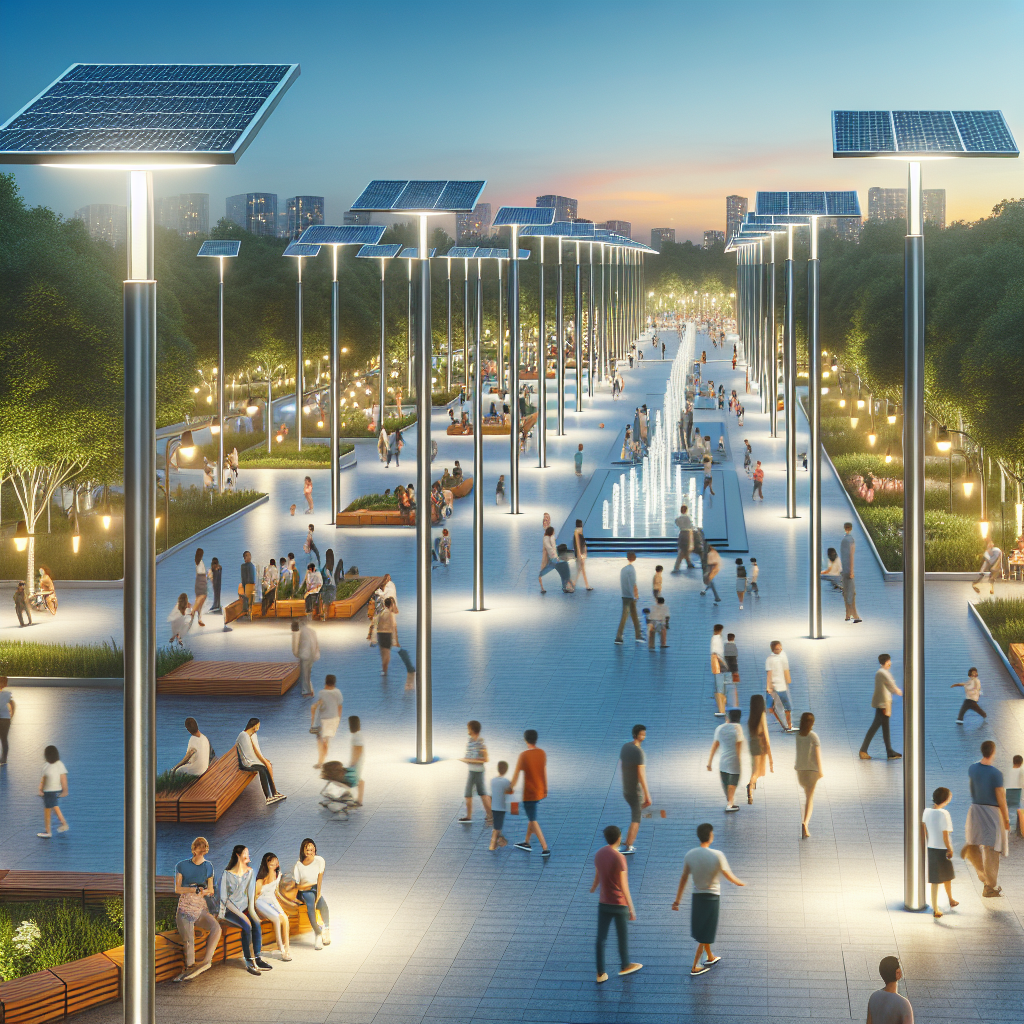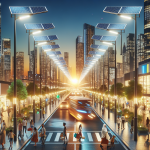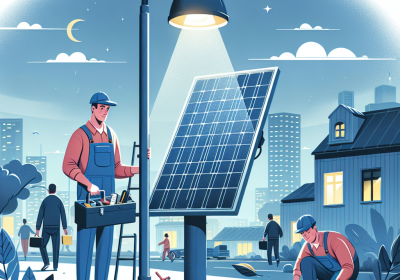Improving Public Spaces with Commercial Solar Street Lighting
Table of Contents
Improving public spaces with commercial solar street lighting represents a transformative approach to urban development and sustainability. As cities worldwide grapple with the dual challenges of enhancing public safety and reducing carbon footprints, solar street lighting emerges as a viable solution. These systems harness renewable solar energy, reducing reliance on traditional power sources and minimizing environmental impact. By illuminating streets, parks, and communal areas, solar street lights enhance visibility and safety, encouraging community engagement and economic activity after dark. Moreover, their installation is often more cost-effective and less disruptive than conventional lighting, as they require no extensive wiring or trenching. This innovative technology not only contributes to a greener planet but also fosters vibrant, accessible, and secure public spaces, ultimately improving the quality of urban life.
Enhancing Urban Safety with Solar-Powered Street Lighting
In recent years, the integration of solar-powered street lighting into urban environments has emerged as a transformative approach to enhancing public safety. As cities continue to expand and populations grow, the demand for efficient and sustainable lighting solutions becomes increasingly critical. Solar street lighting offers a compelling answer to this demand, providing a reliable and eco-friendly alternative to traditional lighting systems. By harnessing the power of the sun, these systems not only reduce energy consumption but also contribute to a safer and more secure urban landscape.
One of the primary benefits of solar-powered street lighting is its ability to operate independently of the electrical grid. This independence ensures that even during power outages, streets remain illuminated, thereby reducing the risk of accidents and crime. In many urban areas, inadequate lighting is a significant factor contributing to unsafe conditions. By implementing solar street lights, municipalities can ensure consistent illumination, which is crucial for both vehicular and pedestrian safety. Moreover, the presence of well-lit streets acts as a deterrent to criminal activities, as potential offenders are less likely to operate in areas where they can be easily observed.
In addition to enhancing safety, solar street lighting is an environmentally sustainable solution. Traditional street lights rely heavily on fossil fuels, contributing to greenhouse gas emissions and environmental degradation. In contrast, solar-powered lights utilize renewable energy, significantly reducing the carbon footprint of urban lighting. This shift towards sustainable energy sources aligns with global efforts to combat climate change and promote environmental stewardship. Furthermore, solar street lights require minimal maintenance compared to conventional lighting systems, as they are equipped with durable components designed to withstand harsh weather conditions. This durability translates into long-term cost savings for municipalities, allowing them to allocate resources to other critical areas of urban development.
The economic advantages of solar street lighting extend beyond maintenance savings. The initial investment in solar technology is often offset by the reduction in energy costs over time. As solar panels become more efficient and affordable, the return on investment for solar street lighting systems continues to improve. Additionally, many governments offer incentives and subsidies to encourage the adoption of renewable energy solutions, further enhancing the financial viability of these projects. By investing in solar street lighting, cities not only improve public safety but also demonstrate fiscal responsibility and forward-thinking urban planning.
Moreover, the implementation of solar street lighting can have a positive impact on community well-being. Well-lit public spaces encourage outdoor activities and social interactions, fostering a sense of community and belonging among residents. Parks, pathways, and recreational areas become more accessible and inviting, promoting healthier lifestyles and enhancing the overall quality of life. As urban areas strive to become more livable and inclusive, the role of solar street lighting in creating vibrant and safe public spaces cannot be overstated.
In conclusion, the adoption of commercial solar street lighting represents a significant step forward in enhancing urban safety and sustainability. By providing reliable illumination, reducing environmental impact, and offering economic benefits, solar-powered street lights are an essential component of modern urban infrastructure. As cities continue to evolve, embracing innovative solutions like solar street lighting will be crucial in creating safer, more sustainable, and more connected communities.
Sustainable Design: The Role of Solar Lighting in Public Spaces

In recent years, the integration of sustainable design principles into urban planning has become increasingly important as cities strive to reduce their carbon footprints and enhance the quality of life for their residents. One innovative solution that has gained significant traction is the use of commercial solar street lighting in public spaces. This technology not only offers an environmentally friendly alternative to traditional lighting systems but also provides numerous economic and social benefits. As urban areas continue to expand, the demand for efficient and sustainable lighting solutions has never been more critical.
To begin with, solar street lighting harnesses the power of the sun, a renewable energy source, to illuminate public spaces. This approach significantly reduces the reliance on fossil fuels, thereby decreasing greenhouse gas emissions and contributing to a cleaner environment. By utilizing photovoltaic panels to capture sunlight and convert it into electricity, solar street lights operate independently of the grid. This independence not only ensures a reduction in energy consumption but also provides a reliable lighting solution in areas where access to electricity is limited or non-existent.
Moreover, the economic advantages of solar street lighting are noteworthy. Although the initial investment in solar technology may be higher compared to conventional lighting systems, the long-term savings are substantial. Solar street lights require minimal maintenance and have a longer lifespan, which translates into reduced operational costs over time. Additionally, the absence of wiring and trenching during installation further lowers expenses, making solar lighting a cost-effective option for municipalities and developers. As a result, the allocation of public funds can be redirected towards other essential services, thereby enhancing the overall development of urban areas.
In addition to environmental and economic benefits, solar street lighting also plays a crucial role in improving public safety and social well-being. Well-lit public spaces deter criminal activities and create a sense of security among residents and visitors. By ensuring that parks, pathways, and streets are adequately illuminated, solar street lights contribute to a safer urban environment. Furthermore, the presence of reliable lighting encourages outdoor activities and social interactions, fostering a sense of community and improving the quality of life for city dwellers.
Transitioning to the aesthetic aspect, solar street lighting offers versatile design options that can enhance the visual appeal of public spaces. With advancements in technology, solar lights are available in various styles and configurations, allowing urban planners to select designs that complement the architectural and cultural characteristics of their cities. This flexibility not only adds to the charm of public spaces but also promotes a sense of identity and pride among residents.
In conclusion, the integration of commercial solar street lighting into public spaces represents a significant step towards sustainable urban development. By leveraging renewable energy, cities can reduce their environmental impact while reaping economic benefits and enhancing public safety. As technology continues to evolve, the potential for solar lighting to transform urban landscapes becomes increasingly apparent. Therefore, it is imperative for city planners, policymakers, and stakeholders to prioritize the adoption of solar street lighting as part of their sustainable design strategies. In doing so, they will not only contribute to a more sustainable future but also create vibrant, safe, and aesthetically pleasing public spaces for generations to come.
Cost-Effective Solutions for Modernizing Public Infrastructure with Solar Street Lights
In recent years, the modernization of public infrastructure has become a focal point for urban planners and local governments striving to create more sustainable and efficient communities. Among the various strategies being employed, the integration of commercial solar street lighting stands out as a particularly cost-effective solution. This innovative approach not only addresses the pressing need for improved public spaces but also aligns with broader environmental goals by reducing reliance on traditional energy sources.
To begin with, the financial implications of transitioning to solar street lighting are notably favorable. Traditional street lighting systems often incur significant costs related to electricity consumption and maintenance. In contrast, solar street lights harness energy from the sun, thereby eliminating electricity costs and reducing the financial burden on municipal budgets. Furthermore, advancements in solar technology have led to the development of more efficient photovoltaic panels and energy storage systems, which enhance the reliability and performance of solar street lights. As a result, the initial investment in solar infrastructure is increasingly offset by long-term savings, making it an economically viable option for many communities.
Moreover, the environmental benefits of solar street lighting cannot be overstated. By utilizing renewable energy, these systems contribute to a reduction in greenhouse gas emissions, which is crucial in the fight against climate change. This shift towards cleaner energy sources is not only beneficial for the environment but also serves to improve public health by reducing air pollution. Additionally, solar street lights operate independently of the grid, providing a resilient lighting solution that remains functional during power outages. This aspect is particularly advantageous in areas prone to natural disasters, where maintaining public safety and accessibility is paramount.
In addition to cost and environmental considerations, the implementation of solar street lighting can significantly enhance the aesthetic and functional quality of public spaces. Well-lit areas are known to deter criminal activity, thereby increasing the safety and security of neighborhoods. This improvement in public safety can lead to greater community engagement and a more vibrant urban environment. Furthermore, the design flexibility of solar street lights allows for creative and customized lighting solutions that can enhance the visual appeal of parks, pathways, and other communal areas. This adaptability ensures that public spaces are not only functional but also inviting and enjoyable for residents and visitors alike.
Transitioning to solar street lighting also aligns with the growing trend of smart city initiatives. Many modern solar street lights are equipped with sensors and connectivity features that enable remote monitoring and control. This integration of technology allows for more efficient management of lighting systems, including the ability to adjust brightness levels based on real-time conditions or usage patterns. Such capabilities not only optimize energy consumption but also provide valuable data that can inform future urban planning decisions.
In conclusion, the adoption of commercial solar street lighting presents a multifaceted opportunity for modernizing public infrastructure. By offering a cost-effective, environmentally friendly, and aesthetically pleasing solution, solar street lights address several key challenges faced by urban areas today. As cities continue to evolve and prioritize sustainability, the role of solar street lighting in enhancing public spaces is likely to become increasingly prominent. Through strategic investment and implementation, communities can reap the numerous benefits of this innovative technology, ultimately contributing to a more sustainable and livable urban future.
Read more about Solar Street Lighting:









